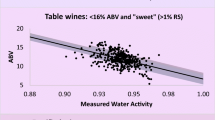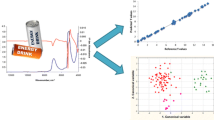Abstract
The volumetric coefficient of thermal expansion (CTE) of diverse alcoholic beverages and aqueous ethanol–sucrose mixtures was calculated by a simple experiment in the temperature range of 5–30°C at atmospheric pressure. The temperature and volume corresponding changes were measured using a basic device as a dilatometer type. Alcohol degree, titratable acidity, volumetric mass, total dry extract, reducing sugars, total polyphenol index, and conductivity in different wine types and other alcoholic beverages were studied to correlate with CTE values. Multivariate techniques were used to study the data, essentially to reveal any widespread patterns in the alcoholic beverages. Additionally, the error of the CTE measurements was also estimated. The CTE obtained results for alcoholic beverages ranged from 1.9 ± 0.3 (×10−4°C−1) for white wines to 11.7 ± 0.4 (×10−4°C−1) for rectified alcohol samples. In the sucrose–ethanol–water mixtures the experimental results of CTE ranged from 2.0 to 6.5 ± 0.01 (×10−4°C−1). Based on the results obtained, the CTE values depend mainly of alcohol degree and volumetric mass of the samples. The knowledge of volumetric coefficient of thermal expansion will be useful to estimate thermal induced volume changes and to check the accurate quantities in stored bulk beverages or during its ageing.






Similar content being viewed by others
Abbreviations
- CTE:
-
Volumetric coefficient of thermal expansion
- TDE:
-
Total dry extract
- TPI:
-
Total polyphenol index
- Φ V :
-
Apparent average molar volume, in millilitres per mole
- V 2 :
-
Apparent specific molar volume, in millilitres per gram
- \( \overline M \) :
-
Average molecular weight, in grams per mole
- ρ :
-
Density, in grams per millilitre
- δ:
-
Error measurement, in percent
- S v :
-
Experimental slope, in millilitres kilograms per square mole
- \( \varphi_{\text{V}}^0 \) :
-
Limiting apparent molar volume, in millilitres per mole
- m S :
-
Molality, in moles per kilogram
- T :
-
Temperature, in degrees Celsius
- V :
-
Volume, in litres
- α V :
-
Volumetric coefficient of thermal expansion, in per degrees Celsius
- α D :
-
Volumetric coefficient of thermal expansion of dilatometer, in per degrees Celsius
References
Apelblat, A., & Manzurola, E. (2005). Volumetric and thermal properties of some aqueous electrolyte solutions part 5. Potassium bromide and potassium iodide 0.1, 0.5, and 1.0 mol kg−1 solutions at temperatures from T = 278.15 to 338.15 K. Journal of Molecular Liquids, 118, 77–88.
Bartels, R. A. (1973). Thermal expansion corrections when ΔT is not small. American Journal of Physics, 41, 78–80.
Blouin, J., & Maron, J.-M. (2006). Maîtrise des températures et qualités des vins (pp. 37–39). Paris, France: Ed. Dunod.
Bouchard, A., Horfland, G. W., & Witkamp, G.-J. (2007). Properties of sugar, polyol, and polysaccharide water–ethanol solutions. Journal of Chemical & Engineering Data, 52, 1838–1842.
Collieu, A. M., & Powney, D. J. (1973). The mechanical and thermal properties of materials (pp. 107–115). London, UK: Edward Arnold.
Commission Regulation. (1990). EC 2676/90 of 17 September. Official Journal of the European Communities, L272, 1–192.
Commission Regulation. (2000). EC 2870/00 of 19 December. Official Journal of the European Communities, L333, 20–46.
Dash, U. N., Roy, G. S., & Mohanty, S. (2004). Evaluation of apparent and partial molar volume of potassium ferro- and ferricyanides in aqueous alcohol solutions at different temperatures. Indian Journal of Chemical Technology, 11, 714–718.
Deng, D. Q., & Xu, L. (2003). Measurements of thermal expansion coefficient of phenolic foam at low temperatures. Cryogenics, 43, 465–468.
Dey, P. C., Motin, D. M., Biswas, T. K., & Huque, E. M. (2003). Apparent molar volume and viscosity studies on some carbohydrates in solutions. Monatshefte für Chemie, 134, 797–809.
Dixit, S., Crain, J., Poon, W. C., Finney, J. L., & Soper, A. K. (2002). Molecular segregation observed in a concentrated alcohol–water solution. Nature, 416, 829–832.
Esteve-Zarzoso, B., Peris-Torán, M. J., García-Maiquez, E., Uruburu, F., & Querol, A. (2001). Yeast population dynamics during the fermentation and biological aging of Sherry wines. Applied and Environmental Microbiology, 67(5), 2056–2061.
Ferreira, O., Brignole, E. A., & Macedo, E. A. (2003). Phase equilibria in sugar solutions using the A-UNIFAC model. Industrial and Engineering Chemistry Research, 42(24), 6212–6222.
Furniss, D., & Seddon, A. B. (2008). Thermal analysis of inorganic compound glasses and glass-ceramics. In P. Gabbott (Ed.), Principles and applications of thermal analysis (pp. 410–449). Singapore: Blackwell.
Garai, J. (2006). Correlation between thermal expansion and heat capacity. Computer Coupling of Phase Diagrams and Thermochemistry, 30, 354–356.
Gharsallaoui, A., Rogé, B., Génotelle, J., & Mathlouthi, M. (2008). Relationships between hydration number, water activity and density of aqueous sugar solutions. Food Chemistry, 106, 1443–1453.
Giangiacomo, R. (2006). Study of water–sugar interactions at increasing sugar concentration by NIR spectroscopy. Food Chemistry, 96, 371–379.
Goharshadi, E. K., & Abareshi, M. (2008). Prediction of volumetric and thermodynamic properties of two aromatic-alcohol mixtures using GMA equation of state. Fluid Phase Equilibria, 268, 61–67.
Grimval, G. (1999). Thermophysical properties of materials (pp. 220–237). Amsterdam, The Netherlands: Elsevier.
Guo, J. H., Luo, Y., Augustsson, A., Kashtanov, S., Rubensson, J. E., Shuh, D. K., et al. (2003). Molecular structure of alcohol–water mixtures. Physical Review Letters, 91, 1–4.
Immel, S., & Lichtenthaler, F. W. (1995). The conformation of sucrose in water: a molecular dynamics approach. Liebigs Annalen der Chemie, 7, 1925–1937.
Kapoor, K., & Dass, N. (2009). Temperature dependent study of volume and thermal expansivity of solids based on equation of state. Indian Journal of Pure and Applied Physics, 47, 592–596.
Koribilli, N., Aravamudan, K., & Varadhan, M. U. (2011). Quantifying enhancement in heat transfer due to natural convection during canned food thermal sterilization in a still retort. Food Bioprocess Technology, 4, 429–450.
LaCombe, J. C., Oudemool, J. L., Koss, M. B., Bushnell, L. T., & Glicksman, M. E. (1997). Measurement of thermal expansion in liquid succinonitrile and pivalic acid. Journal of Crystal Growth, 173, 167–171.
Lide, D. R. (Ed.). (2005). CRC handbook of chemistry and physics (85th ed., pp. 1127–1128). Boca Raton, FL, USA: CRC.
Loukili, A., Chopin, D., Khelidj, A., & Le Touzo, J. Y. (2000). A new approach to determine autogenous shrinkage of mortar at an early age considering temperature history. Cement and Concrete Research, 30, 915–922.
Mathlouthi, M. (1981). X-ray diffraction study of the molecular association in aqueous solutions of D-fructose, D-glucose, and sucrose. Carbohydrate Research, 91, 113–123.
Mathpal, R., Joshi, B. K., Joshi, S., & Kandpal, N. D. (2006). Intermolecular forces of sugars in water. Monatshefte für Chemie, 137, 375–379.
McCain, D. C., & Markley, J. L. (1986). The solution conformation of sucrose: concentration and temperature dependence. Carbohydrate Research, 152, 73–80.
Millero, F. J. (1971). Molal volumes of electrolytes. Chemical Reviews, 71(2), 147–176.
Moreno, J. A., Zea, L., Moyano, L., & Medina, M. (2005). Aroma compounds as markers of the changes in Sherry wines subjected to biological ageing. Food Control, 16, 333–338.
Mújica-Paz, H., Valdez-Fragoso, A., Tonello-Samson, C., Welti-Chanes, J., & Torres, J. A. (2011). High-pressure processing technologies for the pasteurization and sterilization of foods. Food and Bioprocess Technology, 4, 969–985.
Natta, J. M., & Garí, M. (2004). Coeficiente de dilatación cúbica de mezclas etanol–agua. Control de mermas en la fabricación de aguardientes compuestos. Alimentación Equipos y Tecnología, 194, 43–48.
Norton, T., & Sun, D.-W. (2008). Recent advances in the use of high pressure as an effective processing technique in the food industry. Food and Bioprocess Technology, 1, 2–34.
Nose, A., & Hojo, M. (2006). Hydrogen bonding of water–ethanol in alcoholic beverages. Journal of Bioscience and Bioengineering, 102, 269–280.
Nose, A., Hamasaki, T., Hojo, M., Kato, R., Uehara, K., & Ueda, T. (2005). Hydrogen bonding in alcoholic beverages (distilled spirits) and water–ethanol mixtures. Journal of Agricultural and Food Chemistry, 53, 7074–7081.
Office International de la Vigne et du Vin. (OIV). (1990). Recueil des méthodes internationales d´analyses des vins et des moûts. Paris, France: Ed. Dunod.
Onori, G., & Santucci, A. (1996). Dynamical and structural properties of water/alcohol mixtures. Journal of Molecular Liquids, 69, 161–181.
Parke, S. A., & Birch, G. G. (1999). Solution properties of ethanol in water. Food Chemistry, 67, 241–246.
Parke, S. A., Birch, G. G., Portmann, M. O., & Kilcast, D. (1999). A study of the solution properties of selected binary mixtures of bulk and intense sweeteners in relation to their psychophysical characteristics. Food Chemistry, 67, 247–259.
Ribereau-Gayon, J., Peynaud, E., Sudraud, P., & Ribereau-Gayon, P. (1972). Analyse et controle des vins. Paris, France: Ed. Dunod.
Sato, T., Chiva, A., & Nozaki, R. (1999). Dynamical aspects of mixing schemes in ethanol–water mixtures in terms of the excess partial molar activation free energy, enthalpy, and entropy of the dielectric relaxation process. Journal of Chemical Physics, 100(5), 2508–2521.
Serghat, S., Mathlouthi, M., Hoopman, T., & Birch, G. G. (1992). Solute–solvent interactions and the sweet taste of small carbohydrates. Part 1: effect of solvent polarity on solution properties. Food Chemistry, 45, 25–32.
Seuvre, A. M., & Mathlouthi, M. (2010). Solutions properties and solute–solvent interactions in ternary sugar–salt–water solutions. Food Chemistry, 122, 455–461.
Tarek, M., Tobias, D. J., & Klein, M. L. (1996). Molecular dynamics investigation of an ethanol–water solution. Physica A, 231, 117–122.
Tep, Y., & Brun, S. (1989). Variation du volume liquide en fonction de la température. Revue Francaise d’Oenologie, 119, 9–13.
Tipler, P. A., & Mosca, G. P. (2007). Physics for scientists and engineers vol I (6th ed., pp. 666–670). New York, USA: Worth.
Touloukian, Y. S., Kirby, R. K., Taylor, R. E., & Desai, P. D. (1976). Thermophysical properties of matters. Thermal expansion of metallic elements and alloys, vol 12. New York, USA: IFI/Plenum.
Wakisaka, A., & Matsuura, K. (2006). Microheterogeneity of ethanol–water binary mixtures observed at the cluster level. Journal of Molecular Liquids, 129, 25–32.
Wang, Z. D., & Jiang, S. Q. (2006). Coefficient of thermal expansion of stressed thin films. Transactions of Nonferrous Metals Society of China, 16, s220–s225.
Weast, R. C. (1965). Handbook of chemistry and physics (46th ed., p. F-4). Cleveland, USA: Chem. Rubber.
Wolff, E. G. (2006). Technique for volumetric expansion of liquids and solids from 200-400K. In: Proceeding of the 16th International Thermal Expansion Symposium, ITCC28/ITES 16, pp. 556. Lancaster, PA, USA: DEStech.
Yaws, C.L. (1997). Coefficient of thermal expansion. In: Yaws CL (ed) Handbook of chemical compound data for process safety (pp. 145–173). Elsevier.
Zuritz, C. A., Muñoz, E., Mathey, H. H., Pérez, E. H., Gascón, A., Rubio, L. A., et al. (2005). Density, viscosity and coefficient of thermal expansion of clear grape juice at different soluble solid concentrations and temperatures. Journal of Food Engineering, 71, 143–149.
Author information
Authors and Affiliations
Corresponding author
Rights and permissions
About this article
Cite this article
Espejo, F., Armada, S. Determination of Volumetric Coefficients of Thermal Expansion in Alcoholic Beverages and Aqueous Ethanol–Sucrose Mixtures by Differential Volume Measurements. Food Bioprocess Technol 5, 2805–2818 (2012). https://doi.org/10.1007/s11947-011-0658-8
Received:
Accepted:
Published:
Issue Date:
DOI: https://doi.org/10.1007/s11947-011-0658-8




